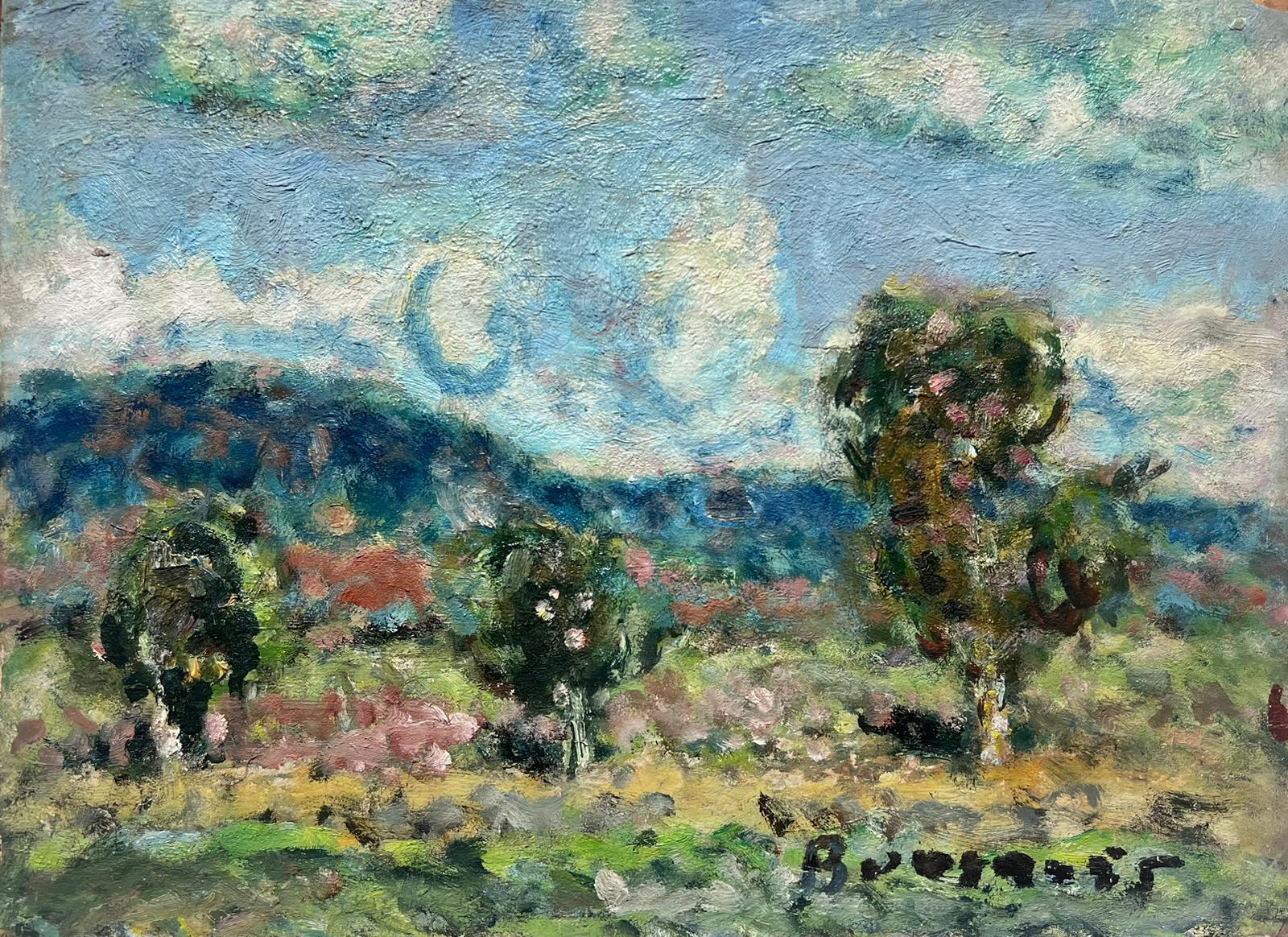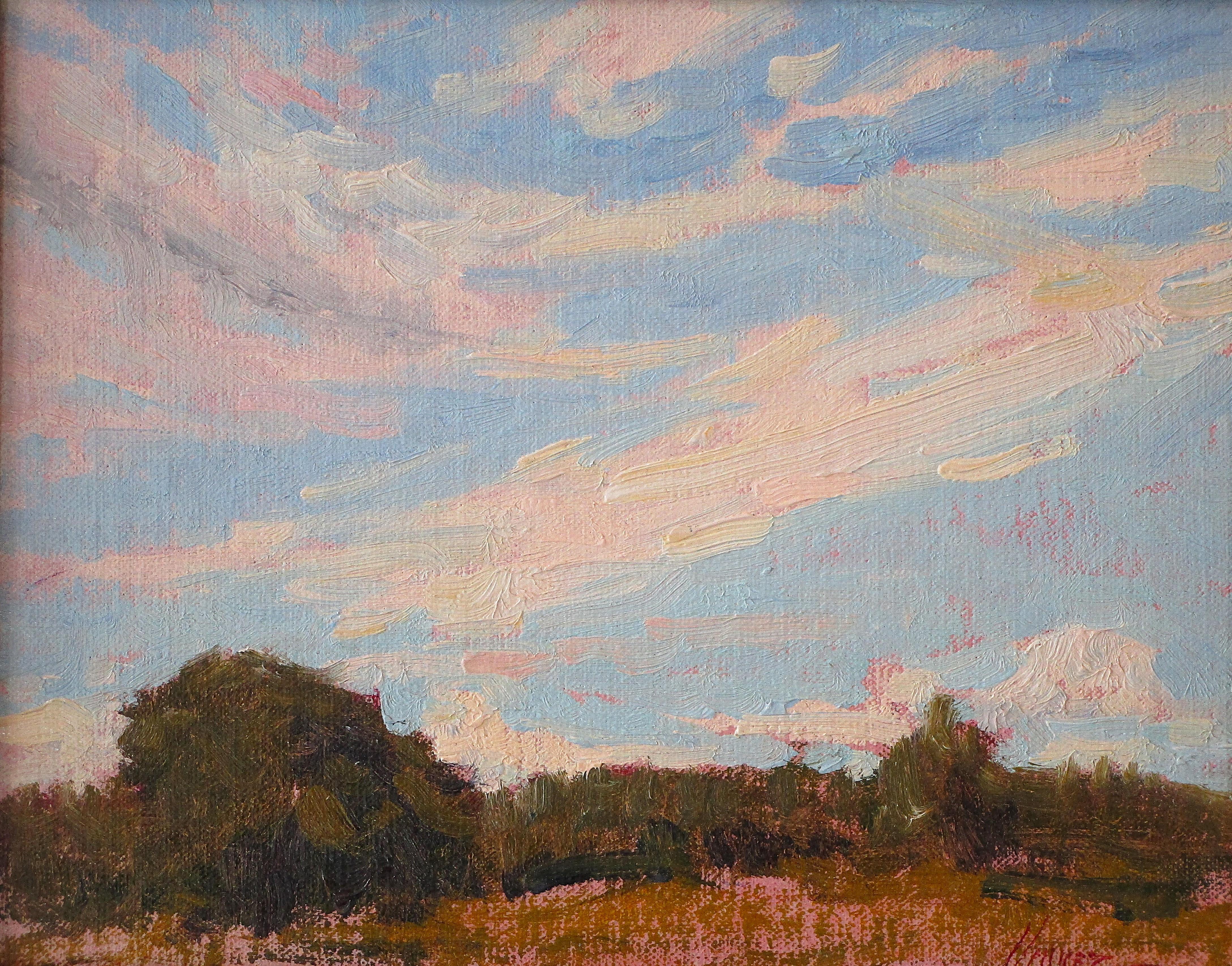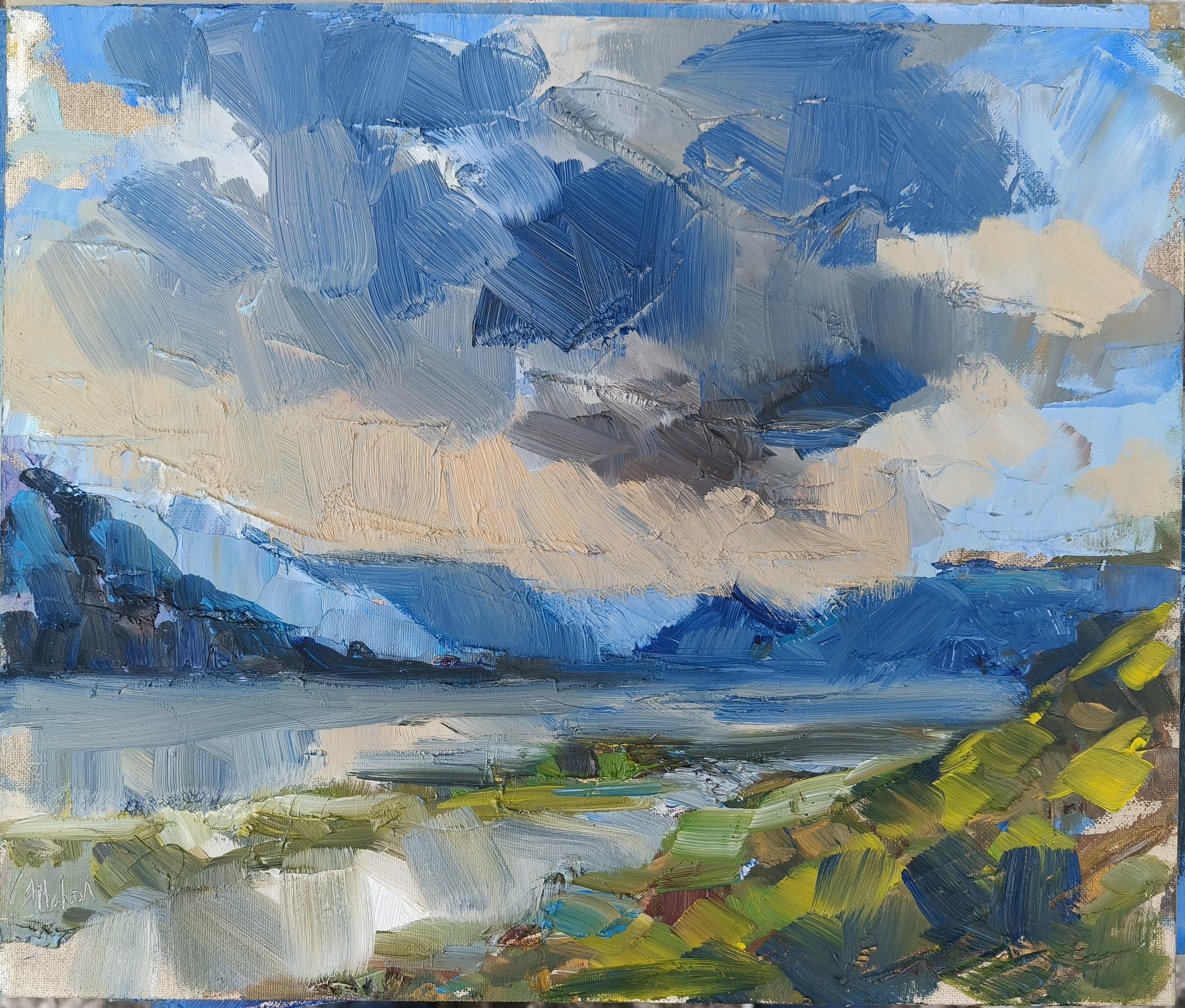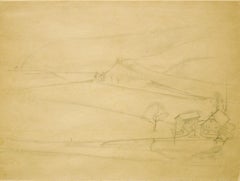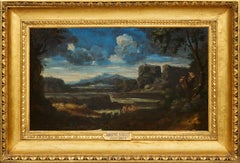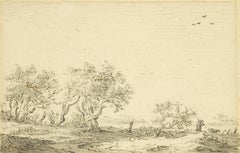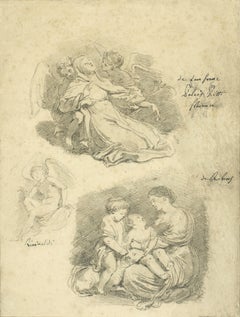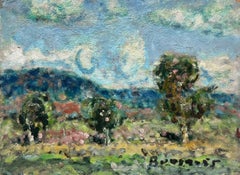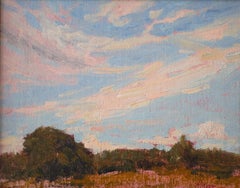Items Similar to Two Studies of Clouds, a double-sided oil on panel by Henri Martin (ca. 1886)
Want more images or videos?
Request additional images or videos from the seller
1 of 7
Henri MartinTwo Studies of Clouds, a double-sided oil on panel by Henri Martin (ca. 1886)ca. 1886
ca. 1886
$13,136.91
£9,707.39
€11,000
CA$18,198.42
A$19,891.53
CHF 10,476.39
MX$244,585.50
NOK 130,925.97
SEK 123,175.50
DKK 83,764.22
About the Item
This rare double-sided oil on panel, probably painted during the summer of 1886, is an interesting testimony to the artist's style development. It present two complementary paintings : on one side (probably the first to have been executed) "Pink-gold Clouds in Summer over the Hills of the South-West of France", on the other side "Stormy Sky". After the return from his trip to Italy in 1885, Henri Martin gradually moved away from academicism and symbolism to find his own style, working under the influence of Seurat and Pointillism.
1. 1885 - 1887, a turning point in the young artist's career
A French painter and figure of Postimpressionism, Henri Martin showed a talent for drawing from an early age. After working, as his parents wished, for a linen merchant , he entered the Ecole des Beaux-Arts in his native Toulouse. He graduated at the age of nineteen, winning the Grand Prix and a scholarship. He then continued his apprenticeship at the Ecole des Beaux-Arts in Paris, where he studied under Jean-Paul Laurens. From 1880 to 1889, he exhibited at the Salon des Artistes Français, exhibiting works in the traditional spirit, executed using an academic technique.
In 1885, he won a travel grant that enabled him to visit Italy and study the primitives with Edmond Aman-Jean. His discovery of Mediterranean light, the Giotto's paintings and his encounter with Segantini had a major influence on his work. Through his friend Aman-Jean, who was close to Seurat, Henri Martin became interested in pointillist research and radically changed his technique. Our work, painted according to Madame Destrebecq-Martin around 1886, is an interesting example of the artist's search for greater freedom in his painting style.
At the 1889 Salon des Artistes Français, he exhibited "La Fête de la Fédération", a choppy, parallel brushstroke depiction of Lafayette taking the oath on the altar of the fatherland. This was the first time the painter dared to lighten his palette to such an extent, juxtaposing his colors in small, grainy heaps. From now on, he would use clear color scheme, decomposing tones to express the vibrations of light. Henri Martin also established himself as an outstanding decorator, with numerous public commissions . He gradually moved away from the Symbolist themes of his early years towards a style combining Fauvism and Pointillism.
Around 1890, he discovered the Quercy countryside and bought a house in La Bastide-du-Vert near Cahors. He stayed there for many years, painting rural and family scenes. In 1912, he bought a house in Saint-Cirq-Lapopie in the Lot department. Then, in 1923, he moved to Collioure on the Mediterranean coast. This region became a source of inspiration for many of his paintings.
Appointed Commandeur de la Légion d'Honneur in 1914, he was elected to the Académie des Beaux-Arts in 1917, in the painting section. Each of his solo exhibitions, particularly at the Galerie Georges Petit, was a triumph. The Musée Henri Martin in Cahors continues to honor his memory, with a permanent exhibition of some fifty of his paintings.
2. Description of the painting and related artworks
The small format of our work suggests that it was painted outdoors. In fact, it is easy to imagine that both sides of the same panel were painted on the same day, with the painter starting with the Pink-golden Clouds in the late afternoon light, before completing the Stormy Sky on the reverse as the storm approaches.
While the Pink-golden clouds are still executed in a more traditional manner, the Stormy Sky on the reverse is much more expressionistic: the three-dimensional nature of the cumulonimbus is strikingly evoked by the large impastos. This side of the panel seems highly characteristic of the researches of a young artist, who dares to use a freedom of touch on a small format that is hardly to be found in the rest of his work.
The hilly landscape at the foot of the Pink-golden clouds seems to us to be related to that of Les Errances du Berger (The Sheperd’s Wanderings), a painting dated 1885-1887, still influenced by Symbolism and recently sold at Sotheby's.
- Creator:
- Creation Year:ca. 1886
- Dimensions:Height: 5.38 in (13.67 cm)Width: 9.25 in (23.5 cm)
- Medium:
- Movement & Style:
- Period:
- Condition:5 3/8’’ x 9 ¼’’ (13.6 x 23.4 cm) Monogrammed in pencil in the upper left-hand corner of Pink-gold Clouds This artwork will be included in the artist's catalog raisonné currently in preparation by Marie-Anne Destrebecq-Martin (cf. certificate).
- Gallery Location:PARIS, FR
- Reference Number:1stDibs: LU1568216342192
About the Seller
5.0
Vetted Professional Seller
Every seller passes strict standards for authenticity and reliability
Established in 2020
1stDibs seller since 2021
10 sales on 1stDibs
Typical response time: 3 hours
- ShippingRetrieving quote...Shipping from: PARIS, France
- Return Policy
Authenticity Guarantee
In the unlikely event there’s an issue with an item’s authenticity, contact us within 1 year for a full refund. DetailsMoney-Back Guarantee
If your item is not as described, is damaged in transit, or does not arrive, contact us within 7 days for a full refund. Details24-Hour Cancellation
You have a 24-hour grace period in which to reconsider your purchase, with no questions asked.Vetted Professional Sellers
Our world-class sellers must adhere to strict standards for service and quality, maintaining the integrity of our listings.Price-Match Guarantee
If you find that a seller listed the same item for a lower price elsewhere, we’ll match it.Trusted Global Delivery
Our best-in-class carrier network provides specialized shipping options worldwide, including custom delivery.More From This Seller
View AllStudy for « Paysage de Fribourg » - 1943 a drawing by Balthus (1908 - 2001)
By Balthus (Balthasar Klossowski de Rola)
Located in PARIS, FR
Provenance: Frédérique Tison, Château de Chassy (Burgundy-Franche Comté - France)
Bibliography: J. Clair, V. Monnier Balthus, catalogue raisonné of the complete works, Gallimard, Pa...
Category
1940s Modern Landscape Drawings and Watercolors
Materials
Paper, Pencil
Italian Landscape with Jack Players, a painting by Gaspard Dughet (1615 - 1675)
By Gaspard Dughet
Located in PARIS, FR
Here Gaspard Dughet offers us an idyllic vision of the Roman countryside. The stages follow one another in a perfectly structured composition, revealing here a lake, there travellers walking along, gradually leading our eye to the blue horizon. But behind its classical composition, this landscape is particularly interesting because of three anthropomorphic details that the artist has hidden, opening the way to a radically different interpretation...
1. Gaspard Dughet, a landscape artist in the light of Poussin
Gaspard Dughet was born on June 4th, 1615 in Rome where his father, of French origin, was a pastry cook. He was probably named Gaspard in honour of his godfather Baron Gaspard de Morant, who was, or may have been, his father's employer. His older sister Jeanne married the painter Nicolas Poussin (1594 - 1655) on September 1st, 1630. The young Gaspard was apprenticed with his brother-in-law at the beginning of 1631, which led his entourage to name him Gaspard Poussin. The first preserved works of the painter date from the years 1633-1634 and were painted in Poussin’s studio.
Around 1635, Gaspard Dughet became emancipated and began to frequent the Bamboccianti circle. In 1636, he became friends with the painter Jean Miel (1599 - 1656), but also with Pier Francesco Mola (1612 - 1666) and Pietro da Cortona (1596 - 1669).
This was also the time of his first trips throughout Italy. The painter, although of French origin, appears never to have visited France. In 1646 he settled permanently in Rome. A recognized painter with a solid book of orders, he remained faithful to landscape painting throughout his life, alternating between cabinet paintings and large decorative commissions, using both oil and fresco.
Nailed to his bed by rheumatic fever at the age of 58, he died on May 25, 1675.
2. Discovering an idealized landscape
Beyond a relatively dark foreground that takes us into the landscape, we discover a vast bluish horizon: a plateau surrounded by deep ravines advances to the right, overhanging an expanse of water that sparkles below. A road winds through a mountainous mass as if leading us to the fortress that crowns it; another town appears in the distance at the foot of three conical mountains.
The composition is rigorous, mineral, and structured by geometric volumes. The various stages in the landscape lead one to the next attracting the eye towards the horizon located in the middle of the canvas. The general impression is that of a welcoming and serene nature.
In many places the paint layer has shrunk, or become transparent, revealing the dark red preparation with which the canvas was covered and accentuating the contrasts.
Human presence is limited to three jack players, leaning against a mound in the foreground. Their long garments, which may evoke Roman togas, contribute to the timelessness of the scene.
Close examination of the canvas reveals two other travellers on the path winding between the rocks. Made tiny by the distance, their introduction in the middle register, typical of Dughet's art, lengthens the perspective.
While it is difficult to date the work of a painter who devoted his entire life to the representation of landscapes, it is certain that this painting is a work from his later years. The trees that occupied the foreground of his youthful compositions have been relegated to the sides, a stretch of water separates us from the arid mountains counterbalanced by two trees represented on the opposite bank. The introduction of this stretch of water in the middle of the landscape betrays the influence of the Bolognese and in particular of the Dominiquin (1581 - 1641)
A number of similarities with a drawing in the British Museum might suggest a date around 1656-1657, since, according to Marie-Nicole Boisclair , it has been compared with the Prado's Landscape with the Repentant Magdalene, painted at that period.
3. Three amazing anthropomorphic details
While some late Renaissance landscapes offer a radical double reading, allowing one to see both a face or a human body behind the representation of a landscape, it seems interesting to us to hypothesize that Gaspard Dughet had fun here by slipping in a few details that, taken in isolation, evoke human or animal figures.
We will give three examples, looking closely at a cloud, the trunk of a broken tree and the top of a cliff.
The main cloud could thus evoke a Christ-like face or that of an antique god...
Category
1650s Old Masters Landscape Paintings
Materials
Oil
Landscape with Trees and a Fisherman walking, a drawing by Jan Van Goyen
By Jan Josefsz Van Goyen
Located in PARIS, FR
No Dutch draughtsman ever captured the atmosphere of the rural countryside of Holland with the same atmospheric and engaging simplicity that Van Goyen achieved in drawings such as this. Indeed, his landscapes were seminal in the development of the genre. The present sketch conveys a striking sense of movement within the natural landscape, conveyed by the deftly applied strokes of chalk, from which the artist’s hand can be sensed. The composition is characteristic of his work, with the low horizon affording significance to the broad sky and the soaring birds within. This feeling of windswept motion powerfully evokes the expansive Dutch farmland with which he was evidently preoccupied.
1. Jan van Goyen...
Category
1650s Old Masters Landscape Drawings and Watercolors
Materials
Chalk, Ink, Laid Paper
Three studies executed in the Pitti Palace in 1761 by Jean-Honoré Fragonard
By Jean-Honoré Fragonard
Located in PARIS, FR
This brilliant study sheet, of which we present here a counterproof, is a souvenir of Fragonard's return journey from Italy. Between April and September 1761, he accompanied the abbot of Saint-Non on his way back to France. Three studies after the masters taken from the Pitti Palace’s gallery in Florence are gathered on this sheet. Although The Ecstasy of Saint Margaret...
Category
1760s Old Masters Figurative Drawings and Watercolors
Materials
Carbon Pencil
River Landscape with Shepherds and Architecture, a painting by Jan van Bunnik
By Jan van Bunnik
Located in PARIS, FR
This painting has been the subject of a study by the art historian Fabrizio Dassie (available on request), confirming its inclusion in Jan van Bunnik’s corpus.
In this painting, Ja...
Category
Late 17th Century Old Masters Landscape Paintings
Materials
Copper
Stag Hunting in the Vicinity of Nuremberg by a German Artist Peter von Bemmel
Located in PARIS, FR
This small landscape shows a hunting scene: two riders are chasing a stag with their dogs at the edge of a forest. Signed by Peter von Bemmel, it is typical of the production of this...
Category
1720s Old Masters Landscape Paintings
Materials
Copper
You May Also Like
Mid 20th Century French Post-Impressionist Signed Oil Fluffy Clouds Landscape
Located in Cirencester, Gloucestershire
Fluffy Clouds over the landscape
signed oil on board, unframed
board: 9.75 x 13 inches
inscribed verso
dated 1958
provenance: private collection, France
condition: very good and soun...
Category
Mid-20th Century Post-Impressionist Landscape Paintings
Materials
Canvas, Oil
"Cloud Movement" (2024) By Lorenzo Chavez, Original Oil Painting of Landscape
By Lorenzo Chavez
Located in Denver, CO
"Cloud Movement" (2024) by Lorenzo Chavez is an original, handmade oil painting that depicts a cloudy landscape in dim evening sunlight.
About the artist:
Born, 1959
Lorenzo Chavez...
Category
21st Century and Contemporary Impressionist Landscape Paintings
Materials
Oil
Cloudy landscape. Oil sketch on cardboard. Unsigned.
By Jules Pierre van Biesbroeck
Located in Paris, FR
Cloudy landscape. Oil sketch on cardboard. Unsigned.
This work will be recorded in the catalogue raisonné of the work of the artist currently in preparation.
Jules Van Biesbroeck was the son of Jules Evariste van Biesbroeck, a painter of Ghent, but was born in Italy, in Portici, near Naples, while his parents were staying there. (In the 19th century many artists made educational trips to Italy). It was a long visit: the child was two years old by the time the family returned to Ghent.[1]
After a short period of practice with his father, van Biesbroeck was enrolled in the Academy of Fine Arts in Ghent. His first painting, "The Shepherd" (French: Le pâtre), was sold at the Triennale in Ghent. In 1888, when he was only 15 years old, he made his debut at the "Salon des Champs-Elysées" in Paris with his monumental work "The Launch of the Argo" (French: Le lancement...
Category
Early 20th Century Impressionist Landscape Paintings
Materials
Oil
Clouds over the sea. 1974, cardboard, oil, 36.5x49 cm
Located in Riga, LV
Clouds over the sea. 1974, cardboard, oil, 36.5x49 cm
Category
1970s Impressionist Landscape Paintings
Materials
Oil, Cardboard
$1,528 Sale Price
20% Off
Landscape with clouds, Painting, Oil on Other
Located in Yardley, PA
Landscape with clouds, Ireland, oil on canvas panel 25x30x0.35 cm :: Painting :: Impressionist :: This piece comes with an official certificate of authenticity signed by the artist :...
Category
2010s Impressionist Paintings
Materials
Oil
Impressionistic Landscape Cloud Oil Painting Michael Budden Sky Study
By Michael Budden
Located in Chesterfield, NJ
Sky Study
oil/panel
7 x 10 image size unframed, is an oil on panel completed in the studio. The painting exudes the rich qualities of oil paint with bright strong color, a variety o...
Category
21st Century and Contemporary Impressionist Landscape Paintings
Materials
Oil
More Ways To Browse
Galerie Was
Christopher Willett Art
Connecticut Landscape Painting
English Beach Paintings
English Castle Art
Frank Chase
French Pointillist
Hoffman Oil
Iceland Painting
James Tower
Landscape With Ducks
Large Painting Oil Ship
Lily Pad Painting
Moulin Rouge Paris Vintage
Napoleonic Paintings
New York Skyline Painting
Nyc Cityscape Paintings
Oil Painting Lake Sunset
